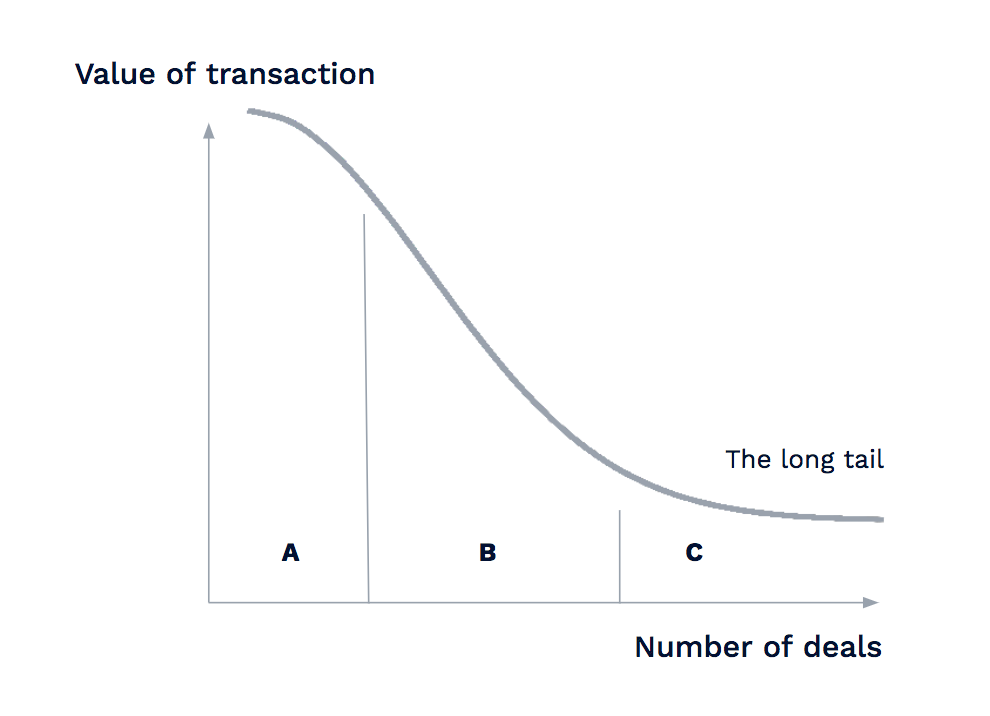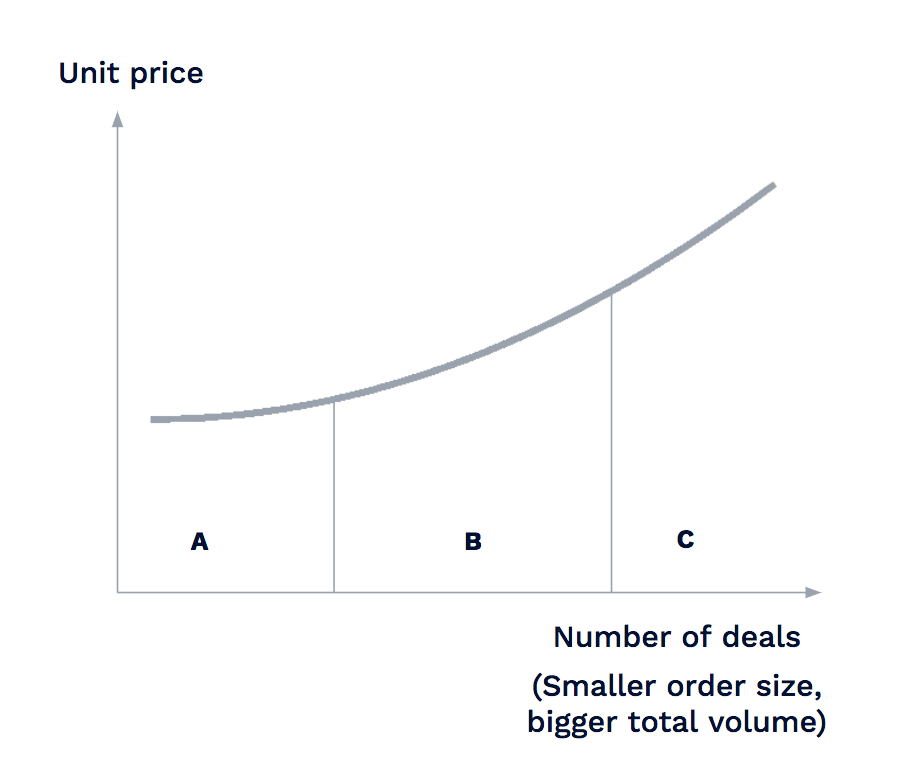The Data Handbook
How to use data to improve your customer journey and get better business outcomes in digital sales. Interviews, use cases, and deep-dives.
Get the book We see it everywhere now. Successful, traditional B2B businesses are exploring opportunities to grow beyond their usual customer segments.
We see it everywhere now. Successful, traditional B2B businesses are exploring opportunities to grow beyond their usual customer segments. Traditionally these players are used to serving very large buyers who make massive orders. The purchasing volumes are so big that it has made sense to allocate precious human labor into sales efforts – these kinds of deals need long-term relationship nurturing. In addition, the delivery of goods is usually complex and tailored, and requires integrated processes with the buyer. Add the combination of high switching costs and fierce competition. It is not an easy game to play for market shares.
On the other hand, this setup offers interesting opportunities for the incumbent companies that have established their position in the market.
Mindset shift towards smaller segments
In recent years, B2B ecommerce systems have taken huge development leaps and common processes have matured. These advancements in technology and supply chain allow established players to go after smaller clients in cost-effective ways. In order to do that, all they need is a self-service order channel (think webstore) with a standardised offering. Throw in some digital marketing and you are ready to expand.Instead of focusing only on the big fish, a vast number of smaller revenue streams become within reach. Large enterprises often have scalable order, delivery and invoicing processes in place. They might need some tuning to serve the new segments, but that’s then just about execution. The graph below illustrates the shift towards the long tail.
 Image 1: Serving the long tail of customers requires being able to sell in smaller batches.
Image 1: Serving the long tail of customers requires being able to sell in smaller batches. Segment A represents the big buyers. In here, you might be selling large batches or just something big such as heavy duty machinery with life cycles of tens of years. Segment B are customers who might purchase a machine like that once in a lifetime. What is the point offering anything to them in this example then?
But that’s the sweet spot. Think about selling spare parts or additional modules for that machinery. The buyers could even be your subcontractors. They might want to tap into your supply chain and get spare parts drop shipped on site. Segment C is even further down the curve. It might not be feasible to sell them anything at all without radically changing what it is that you are selling and how you do it. It is still an opportunity worth considering.
However, to expand outside of segment A, many obstacles need some serious solving.
Solving the supply and demand problem
As said, it’s not all fun and games. This kind of expansion never happens without friction. The first common problem is supply and demand. Can you package the products or services in a way that customers are willing to buy them in smaller quantities? Your market will grow, but your market fit will be worse since you are engaging with a larger audience. Smart application of marketing technology helps here. It makes it possible to promote exactly what you have to exactly those who need it.The second general problem is that the reduction in transaction size introduces overhead. It creates pressure to increase the prices. Automation and even outsourcing can solve this to some extent. And even if you decide to increase prices, the margin will be different. Going for segments B and C is an investment where break-even is dependent on volume.
What kind of volume can we then expect, you might ask. While that’s impossible to forecast accurately, make sure you know your numbers, and you’ll at least see how high you have to jump. It is essential to understand your unique positioning in different value streams. A digital sales strategy must be different across industries and positions.
Different pricing for different segments
We can examine the long tail problem also through another approach. With big, individual transactions the unit price is low. When the transaction size gets smaller, the unit price must go up. The graph below illustrates the corresponding segments A, B, and C.
Image 2: Distribution in smaller batches drives the cost to supply higher. It creates pressure to increase the prices.
The economics of scale play a trick on us here. In the segments towards the long tail the volume goes up, but so does the cost to supply. Marginal cost increases since the additional units are sold in smaller batches. This dynamic introduces a need for different pricing models for different customer segments.
In segment A the traditional wisdom has been to customise and integrate the supply chain. It increases the costs of switching vendors through lock-ins. Entering and flourishing in segment B requires a different approach. In there, you should push the boundaries of IT, supply chain, and finance to enable self-service. Segment C represents something close to the direct-to-consumer model – selling to individual consumers. That’s the holy grail companies tend to evaluate regularly. Getting there requires automation in very high degree and an offering you can sell in small quantities. It is also a target that can become a white whale.
Play from the position of strength
Business disruption is not something only small agile entrants can do. The game is on also for the big players. They do have the means and the capital. Are they resilient enough to execute it? While big companies have a lot to learn from startups, I would be cautious in emulating them. Trying to beat someone in their own game just wastes your position. Don’t let go of your advantage by giving up everything you already have achieved.
Did you get inspired? How about further optimising your digital commerce – with the help of our free Digital Commerce Canvas. With the Digital Commerce Canvas, you get a thoroughly holistic yet light kickstart for analysing, planning or redesigning your digital sales and customer acquisition in a 1 to 2 hour workshop.
The Data Handbook
How to use data to improve your customer journey and get better business outcomes in digital sales. Interviews, use cases, and deep-dives.
Get the book



